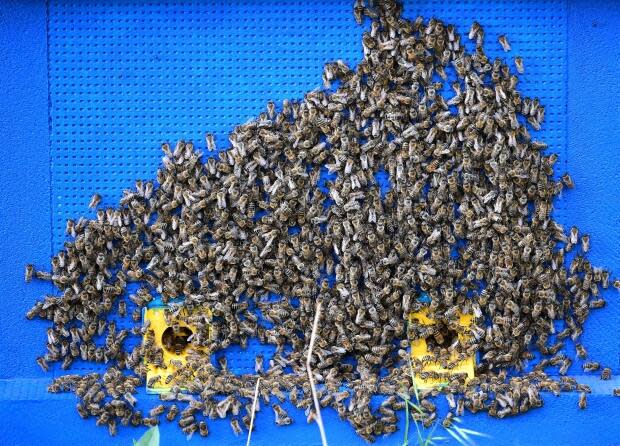Queen bees from Ukraine find a sweet new home in northwestern B.C.

A city in B.C.'s North Coast has become a buzzing haven for unique new visitors courtesy of a local beekeeper.
Christine McDonald, owner of Rushing River Apiaries in Terrace, B.C. — about 575 kilometres west of Prince George — recently took to social media to share her delight over the arrival of 200 Carpathian queen bees and 1,000 accompanying worker bees to her farm from Ukraine, through a beekeeping equipment company in Ontario.
McDonald says she acquired 200 plastic cages of the queen bees, each also containing five worker bees and food.
"I knew that these Carpathians are well known for their rugged survival like mountain honey bees, and also being very gentle," McDonald told host Carolina de Ryk on CBC's Daybreak North.
"Those are the two qualities that we value a lot, especially because we sell these to newer beekeepers, and we want them to be able to comfortably work with their bees."
Imports to Canada since 2020
The Carpathian bees get their name from the Carpathian Mountains, a 1,500-kilometre range spanning Central and Eastern Europe from the Czech Republic to Romania.
Alison McAfee, a honey bee specialist at the University of British Columbia, says Ukraine has a thriving beekeeping industry involving over 600,000 people — approximately 1.5 per cent of the country's population — working with apiaries. Ukraine ranks among the top five honey exporters globally in terms of weight.
In 2020, the Canadian Food Inspection Agency (CFIA) granted approval for Ukraine to export queen bees to Canada.
Prior to Russia's invasion in 2022, which devastated apiaries throughout Ukraine and displaced tens of thousands of beekeepers, the CFIA also authorized the importation of bee packages consisting of a queen bee, several thousands of worker bees, and a brood of larvae in a hive box.
The federal agency says it has issued six permits for importing queen bees from Ukraine this year so far, and some permit holders distribute the bees to apiaries across Canada.

Dancing Bee Equipment, based in Port Hope, Ont., is among distributors of Carpathian queen bees. Individual buyers must travel to Ontario to collect the bees at the airport or the company's warehouse, while commercial buyers can request a shipment of the bees.
CEO Todd Kalisz says the company has imported over 20,000 queen bees from Ukraine since the start of the war, acknowledging the logistical challenges caused by the ongoing conflict.
"There's no advance notice of the [shipping] schedule … it could change the day after," he said, adding some customers who failed to check the updated schedule were disappointed after making the long drive to Ontario, only to discover their orders hadn't arrived.
Honey by mid-August
McDonald did not encounter such disappointment — her bees arrived via cargo flight two weeks ago.
She also says 95 per cent of the Carpathian queen bees were accepted by her hives.
According to B.C.'s Ministry of Agriculture, the queen bee is responsible for mating with drones, or male honey bees, and laying eggs in the colony, while worker bees gather food to nourish her and her offspring.
McDonald explains that if worker bees do not accept their queen bee, they may opt to kill her and raise their own queen instead.
McDonald says she has since sold 130 bee colonies containing Carpathian queen bees to hobbyist beekeepers across northern B.C., including Terrace and Prince George, over the past two weeks.
"There was so much excitement about that — people who had already heard it were asking like, 'Oh, does this one have a Ukrainian queen?'" she said, adding she expects the colonies of the Carpathian queen bees to produce honey by mid-August.


